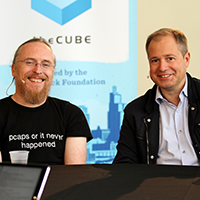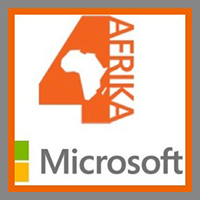In This Issue
- Microservices Jobs
- Cloud Tipping Point
- Telecom Cloud Shifts
- Report from the CEO
- Cyber Executive Order
- Big Data for Military
- Microservices Twist
- Cloud & Mixed Reality
- Cloud-Native Media
- Verizon 5G NFV Trials
- Telefonica WAN2Cloud
- MSFT Cloud in Africa
- Cloud in Asia-Pacific
- Inside Data Centers
- Virtualization Step
- Disruptions Feared
- Coming DCIA Events
Microservices Job Postings Soar Over Past 12 Months
Excerpted from CloudTech Report by James Bourne
 If you want to get ahead, get tooled up on microservices as vacancies for job roles have gone up by 133% over the last year, according to the latest report from Rackspace.
If you want to get ahead, get tooled up on microservices as vacancies for job roles have gone up by 133% over the last year, according to the latest report from Rackspace.
Microservices, which enable applications to become more agile and prevent servers from being jammed, are becoming increasingly prevalent in a world of data overload.
Think of the stat, as Microsoft CEO Satya Nadella put it at BUILD earlier this month, that 90% of the data in the world today have been created over the last two years, or the fact that 300 hours of video are uploaded to YouTube every minute, and you get the idea of its importance.
It’s also forcing change in other areas, Rackspace argues.
Job postings for agile software development, a fundamental skill in microservices, went up 16% over the past 12 months, while skills for more traditional service-orientated architecture (SOA) declined by 22%.
Skills with regard to container technologies continued to gain ground in the past year… Read More
Cloud Computing Moves Beyond Tipping Point
Excerpted from HedgeWeek Report by Robert Garrison
 Cloud computing has reached a tipping point, with capabilities and cost efficiencies exceeding those achieved via in-house data centers, according to a white paper from the Depository Trust & Clearing Corporation (DTCC). In the paper, “Moving Financial Market Infrastructure to the Cloud,” DTCC asserts that the capabilities, resiliency, and security of services provided by cloud vendors has surpassed on- premise capabilities. As a result, DTCC will evaluate opportunities to strategically expand the use of the cloud more broadly across its external services and applications where it makes sense, with a goal of leveraging cloud capabilities to reduce risk and cost and improve the resiliency and security of DTCC’s systems. DTCC recognizes that understanding and market acceptance of significant technology changes require industry-wide communication and open discussion. The white paper provides DTCC’s views on the benefits of the public cloud platform… Read More
Cloud computing has reached a tipping point, with capabilities and cost efficiencies exceeding those achieved via in-house data centers, according to a white paper from the Depository Trust & Clearing Corporation (DTCC). In the paper, “Moving Financial Market Infrastructure to the Cloud,” DTCC asserts that the capabilities, resiliency, and security of services provided by cloud vendors has surpassed on- premise capabilities. As a result, DTCC will evaluate opportunities to strategically expand the use of the cloud more broadly across its external services and applications where it makes sense, with a goal of leveraging cloud capabilities to reduce risk and cost and improve the resiliency and security of DTCC’s systems. DTCC recognizes that understanding and market acceptance of significant technology changes require industry-wide communication and open discussion. The white paper provides DTCC’s views on the benefits of the public cloud platform… Read More
Telecom Shifts Strategy to Support Cloud Computing
Excerpted from SiliconAngle Report by Aaron Melgar
 Cloud computing has fundamentally expanded the realm of possibilities organizations can accomplish with technology.
Cloud computing has fundamentally expanded the realm of possibilities organizations can accomplish with technology.
While a lot of focus has been placed on the cloud technology and data architecture advancements, the underlying telecommunications infrastructure is also seeing a shift in strategies to support the latest trends in cloud computing.
Cisco Systems, known for its hardware infrastructure deployments, is helping drive this shift. Ian Wells (pictured, left), distinguished engineer, cloud and platform services at Cisco, and Jerome Tollet, distinguished engineer, Chief Technology and Architecture Office, at Cisco, are two of the company’s team members spearheading this initiative.
Wells and Tollet spoke with host Stu Miniman and guest host John Troyer, of theCUBE, SiliconANGLE Media’s mobile live streaming studio, during OpenStack Summit in Boston, MA.
They discussed their technical perspectives on virtualization and cloud computing.
Of all the advances in telecommunications infrastructure, the most important technology for advancing cloud computing is Network Function Virtualization (NFV), according to Tollet… Read More
Report from DCIA CEO Marty Lafferty

The Federal Communications Commission (FCC) voted 2-to-1 this week to initiate a process to roll back regulations passed in a 2015 Open Internet Order that would have reclassified internet service providers (ISPs) as Title II common carriers.
The vote initiates a ninety-day Notice of Proposed Rulemaking (NPRM) comment period, and FCC Chairman Ajit Pai committed to make public any resulting order before voting on it.
The proposal covers four areas: 1) revocation of Title II internet regulation; 2) reinstatement of mobile broadband as a private mobile service; 3) elimination of the general conduct standard for reviewing possible violations of open internet principles not covered under the rules; and 4) whether to maintain, modify, or eliminate bright-line rules against blocking, throttling, or paid prioritization.
In announcing the decision, Chairman Pai questioned whether there was any need to reclassify ISPs under the heavy-handed and backward-looking regulatory framework of Title II.
He also criticized the general conduct standard, for enabling bureaucrats unfairly to undo business decisions.
He called it a new chapter in protecting a free and open internet, and underscored the fact that companies, interest groups, and the public are invited to comment before the FCC acts by following the facts and law.
Republican Commissioner Michael O’Rielly added that the FCC’s process would be based on a vetting of data, including a cost-benefit analysis, and reviewing the law.
He said the Commission seeks answers to the questions that will lead to establishing a firm legal framework with clarity regarding the FCC’s authority over broadband.
Democratic Commissioner Mignon Clyburn voiced dissent on the decision to move ahead with the NPRM.
Senate Republicans praised the action and discussed the need for compromise legislation to clarify the FCC’s regulatory authority over broadband.
When the comment period closes, the Commission will present a finalized proposal and vote to put it into effect.
The hope is that deregulating internet providers and removing restrictions on business models will incentivize building out broadband networks to reach new, unserverd, and underserved customers, including by smaller operators.
A key question going forward will be how updating the regulatory classification of internet providers will impact other protections of net neutrality the FCC may enact. Share wisely, and take care.
Cybersecurity Community Lauds Executive Order
Excerpted from The Hill Report by Joe Uchill
 President Trump’s cybersecurity executive order has earned positive reviews from the cybersecurity community, who see it as a valuable starting point towards strengthening cyber defenses.
President Trump’s cybersecurity executive order has earned positive reviews from the cybersecurity community, who see it as a valuable starting point towards strengthening cyber defenses.
“It’s a good first step for cybersecurity,” said James Norton, a former Deputy Assistant Secretary in the George W. Bush administration who now works at cybersecurity firm Play-Action Strategies.
“But there will be more steps, including more guidance and funding.”
The executive order had been hotly anticipated since drafts started to leak in the early days of the administration.
Though most cybersecurity experts agreed each successive draft improved on the last, people with vested interests in cybersecurity were impatient for a final release.
While the final draft contained few major surprises based on earlier drafts, its basic components already impressed experts.
“The President’s early focus on cyber is good for the public and private sector,” Kevin Davis, a Vice President at cybersecurity firm Splunk, said… Read More
Big Gains for Big Data in Military Applications
Excerpted from Defense World Report by Amreen Khan
 Amid the proliferation of real-time data from sources such as mobile devices, web, social media, sensors, log files and transactional applications, Big Data has found a way to deliver a wealth and variety of mission-critical data to today’s warfare.
Amid the proliferation of real-time data from sources such as mobile devices, web, social media, sensors, log files and transactional applications, Big Data has found a way to deliver a wealth and variety of mission-critical data to today’s warfare.
The big data techniques used by businesses to mine databases are being adopted by the military to glean more information from many different types of data it collects—from drones, automated cybersecurity systems, terrorist databases and many other sources.
The technology will not only help warfighters on the battlefield, it will also be used to improve fields ranging from software development to vehicle maintenance.
According to a new report from SNS Research titled The Big Data Market: 2017- 2030 – Opportunities, Challenges, Strategies, Industry Verticals & Forecasts, the investments in Big Data solutions are expected to grow at a CAGR of roughly 10 percent over the next four years, reaching $76 billion by the end of 2020.
Big Data investments will account for over $57 Billion in 2017 alone, the report says… Read More
Microservices: Latest Twist in Distributed Computing
Excerpted from ZDNet Report by Joe McKendrick
 We’ve always been trying to break down the monoliths, but now it’s more urgent.
We’ve always been trying to break down the monoliths, but now it’s more urgent.
There’s a new wave of technology — especially microservices and containers — which seeks to break down all the monoliths and silos that have sprung up across enterprise systems over the years.
But is this really a new mode of computing, or simply, as they say, old wine in a new bottle?
This and other questions were explored at a panel convened at the recent Voxxed Days Bristol Conference, which looked at the issues and opportunities in today’s IT environment.
“There’s been this big movement toward decomposing monoliths into microservices, and sticking them into containers, or sticking them out into cloud,” said Dan Hardiker, Chief Technology Officer at Adaptavist.com and moderator of the event.
“It looks like the future is more of this stuff.”
“But aren’t we just swapping one set of problems with which we’re familiar with one set of problems we’re not?” he asked.
To Simon Ritter, Deputy CTO for Azul Systems, microservices and containers are just another distributed computing environment… Read More
Cloud Computing & Mixed Reality: Massive Future Impact on TV
Excerpted from DigitalTVEurope Report
 The long-term growth in internet bandwidth and computing, combined with the detachment and low attention span of millennials for classic TV, will have a massive impact on the traditional media industry over the next few years, with mixed reality likely to play a major role, according to Kai-Christian Borchers, CEO of TV technology outfit 3Screen TV.
The long-term growth in internet bandwidth and computing, combined with the detachment and low attention span of millennials for classic TV, will have a massive impact on the traditional media industry over the next few years, with mixed reality likely to play a major role, according to Kai-Christian Borchers, CEO of TV technology outfit 3Screen TV.
Speaking at the Connected TV World Summit this morning, Borchers said that social media platforms are responding to changes by moving into creating content for their target market and thus retaining their grip on younger age groups.
Borchers pointed to the example of a spectator who broadcast on Periscope the FA Cup match between Manchester City and Crystal Palace and for 139,300 viewers.
Borchers said that disparate sources of content were being aggregated by social media platforms.
While virtual reality may remain a minority activity, the Photonic Lens Chip developed by Magic Leap and mixed and augmented reality propositions could change the name of the game, he said.
Magic Leap-enabled glasses could change the way content is produced and the way we navigate content… Read More
Evolution of Cloud-Native Technology for Media Processing
Excerpted from TV Technology Report by Yaniv Ben-Soussan

Video infrastructure is changing.
Traditionally, broadcast infrastructure was entirely based on hardware.
But as video content and service providers look to launch broadcast and OTT services faster, gain operational efficiencies and reduce OPEX and CAPEX, they are shifting to software-based and cloud workflows.
Cloud-native technology, in particular, provides the agility, flexibility and scalability that are needed today, enabling operators to manage their entire video preparation and delivery workflow via public or private cloud infrastructure.
This article will make several bold predictions about where cloud-native technology is headed for 2017 and beyond.
With a better understanding of the evolution of cloud-native workflows, operators can dramatically simplify their broadcast and OTT operations, while retaining exceptional video quality.
Video content and service providers that want to be successful in the cloud-native environment must approach cloud-native applications as more than just a technology change… Read More
Verizon 5G Trial a Collaborative NFV Effort
Excerpted from SDXCentral Report by Dan Meyer
 Samsung and Cisco scored a win last week when their network functions virtualization (NFV) platforms were announced as components of a multivendor 5G network trial with Verizon.
Samsung and Cisco scored a win last week when their network functions virtualization (NFV) platforms were announced as components of a multivendor 5G network trial with Verizon.
Cisco said the deployment was a collaboration between the vendors, “which was facilitated by Verizon.”
For the trial in Ann Arbor, MI, Cisco provided its virtualized packet core as part of its Ultra Services Platform, working with Samsung’s virtual radio access network (vRAN) product, 5G radio base stations, and home routers.
Cisco said its architecture is based on the ETSI management and orchestration (MANO) platform with a Cisco virtual network function manager (VNFM).
Samsung supplied its NFV-based vRAN powered by a common-off-the-shelf (COTS) x86 architecture, its complete NFV stack with hardware, and MANO software.
The vRAN itself was deployed in Michigan close to the test market, while the platform is managed by the vendor’s ETSI-compliant MANO software, which was deployed on Verizon’s cloud platform in Westlake, TX… Read More
Telefonica Business Solutions Launches WAN2Cloud Service
Excerpted from Capacity Media Report by Jason Mcgee-Abe
 Telefonica Business Solutions has launched a new WAN2Cloud service providing private, secure, and reliable connectivity to public cloud service providers (CSPs) using its global MPLS network.
Telefonica Business Solutions has launched a new WAN2Cloud service providing private, secure, and reliable connectivity to public cloud service providers (CSPs) using its global MPLS network.
With this service, carriers will be able to expand their portfolio without investment or upfront costs, helping their existing customers in their digital transformation by accelerating the deployment of their hybrid cloud solutions.
This migration does come with challenges, particularly for those enterprises who access the internet through CSPs.
They have been experiencing low performance, due to non-traffic prioritization and security issues when connecting to these platforms.
This is where carriers have a key role to play.
It is imperative, as trusted players in this field, that Telefonica supports the migration to this new cloud model in order to meet the needs of its customers.
The WAN2Cloud service offers Telefonica’s carrier customers the best way to connect their current corporate VPN to the CSP… Read More
Microsoft Extends Cloud-Computing Arms Race to Africa
Excerpted from Fox Business Report by Jay Greene
 Microsoft plans to extend the cloud-computing arms race among technology giants into Africa by opening two big data centers there next year.
Microsoft plans to extend the cloud-computing arms race among technology giants into Africa by opening two big data centers there next year.
The data centers, which will serve customers of the software giant’s Azure cloud-computing business, will be the first of their size built in Africa by one of the three major cloud-infrastructure providers — Microsoft, Amazon, and Alphabet’s Google, according to global maps the companies posts online.
Microsoft plans to open the centers in Johannesburg and Cape Town.
Microsoft believes the African tech market is “a pretty ripe opportunity,” said corporate Vice President Julia White.
Microsoft’s cloud computing customers in the market include Standard Bank of South Africa and the South African State Information Technology Agency, she said.
Research firm International Data Corp. estimates that total cloud revenue in South Africa last year was just $243 million, but expects it to grow nearly 20% a year through 2021… Read More
Demand for Managed Cloud Increases in Asia-Pacific
Excerpted from MarketWire Report
 Migration of complex workloads to the cloud will fuel growth opportunities for managed cloud and professional services, finds Frost & Sullivan’s Digital Transformation team
Migration of complex workloads to the cloud will fuel growth opportunities for managed cloud and professional services, finds Frost & Sullivan’s Digital Transformation team
The demand for managed cloud and professional services has increased, especially in countries like Japan, which have a mature cloud landscape.
This is due to complex Big Data and workloads such as enterprise resource planning (ERP) being increasingly migrated to cloud platforms.
The expansion of open-source technologies and advances in application programming interface (API)-accessible single-tenant cloud servers help promote acceptance towards managed private cloud providers.
Immense monetization opportunities arise from competing in the managed cloud space, where service providers can differentiate themselves by offering a robust end-to-end portfolio of cloud services, network connectivity, and security solutions.
Asia-Pacific Cloud Computing Services Market Analysis, Forecast to 2022 is new analysis from Frost & Sullivan… Read More
A Look Inside Tomorrow’s Data Centers
Excerpted from Business World Report by Sanjay Montwani
 India is fast becoming a robust market for data centers, with digital data consumption expected to increase to 2.3 million petabytes in 2020—twice as fast as the worldwide rate. The Indian data center infrastructure market is currently valued at $2.2 billion and is expected to more than double to $4.5 billion by next year.
India is fast becoming a robust market for data centers, with digital data consumption expected to increase to 2.3 million petabytes in 2020—twice as fast as the worldwide rate. The Indian data center infrastructure market is currently valued at $2.2 billion and is expected to more than double to $4.5 billion by next year.
India is poised to be the second-largest market for data centers in Asia-Pacific by 2020 and the investments are expected to reach $7 billion, according to an Internet and Mobile Association of India (IAMAI) report. The Asia Pacific market will experience increased traction and is set to become the biggest market for data center infrastructure over the next five years, forecasts MarketsandMarkets. Without any doubt, the forecast for the data center market seems bright. However, what will the data center look like in the future? Take a peek at how the following trends will shape the data center market in the years to come. Increasingly, the industry is realizing the benefits of building data centers in an area with cold climate to reduce cooling costs… Read More
Virtualization a Vital Stepping Stone to the Cloud
Excerpted from CloudTech Report by Richard Stinton

It is true to say that there has been a lot of talk about virtualization over the years and you would be forgiven for thinking that every server and every storage system has had some kind of virtualization treatment, but there are still some companies out there who have yet to virtualize and indeed realize the benefits that both virtualization and cloud offer.
So for those who have not gone down the virtualization route let me summaries the benefits from a business and technical perspective and whilst we are there let’s take a look at virtualization in the context of cloud adoption and the benefits it brings in a cloud environment.
The need to embrace virtualization normally comes hand in hand with growing hybrid environments and having some of your IT infrastructure in the cloud and some on premise.
In fact virtualization is often seen as a stepping stone into cloud.
Let’s start by looking at the benefits that virtualization brings to the business.
Virtualization can increase IT agility, flexibility, and scalability while creating significant cost savings… Read More
More Disruptions Feared from Cyberattack
Excerpted from Reuters Report by Dustin Volz and Eric Auchard
 Officials across the globe scrambled over the weekend to catch the culprits behind a massive ransomware worm that disrupted operations at car factories, hospitals, shops and schools, while Microsoft on Sunday pinned blame on the US government for not disclosing more software vulnerabilities.
Officials across the globe scrambled over the weekend to catch the culprits behind a massive ransomware worm that disrupted operations at car factories, hospitals, shops and schools, while Microsoft on Sunday pinned blame on the US government for not disclosing more software vulnerabilities.
Cybersecurity experts said the spread of the worm dubbed WannaCry – “ransomware” that locked up more than 200,000 computers in more than 150 countries – had slowed but that the respite might only be brief amid fears new versions of the worm will strike.
In a blog post on Sunday, Microsoft President Brad Smith appeared to tacitly acknowledge what researchers had already widely concluded: The ransomware attack leveraged a hacking tool, built by the US National Security Agency (NSA) that leaked online in April.
“This is an emerging pattern in 2017,” Smith wrote.
“We have seen vulnerabilities stored by the CIA show up on WikiLeaks, and now this vulnerability stolen from the NSA has affected customers around the world… Read More
Coming Events of Interest
Security of Things World — June 12th and 13th in Berlin, Germany. A world class event focused on the next information security revolution. Security concerns that preoccupy enterprise customers today and pragmatic solutions to threats.
Autonomous Systems World — June 14th and 15th in Berlin, Germany. An international knowledge exchange among top experts in the field, providing a unique glimpse into the fascinating world of autonomous robots, intelligent machines, and smart technologies.
INTRASECT — June 29th and 30th in Washington, DC. The first conference of its kind to engage key stakeholders in a comprehensive and engaging examination of existing and future regulatory policy governing the usage of commercial autonomous vehicles.
Industry of Things World Asia — July 3rd and 4th in Singapore. An international knowledge exchange platform bringing together more than 300 high-level executives who play an active role in the industrial internet of things (IoT).
Industry of Things World Europe — September 18th and 19th in Berlin, Germany. Join more than 1,000 high-level executives to rethink your technology and business strategy for scalable, secure, and efficient IoT.
IoT Solutions World Congress — October 3rd through 5th in Barcelona, Spain. This event has grown enormously in no time and is an excellent barometer and source of information, inspiration, collaboration and transformation.
